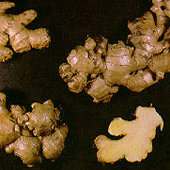
Source: California Department of Food and Agriculture
On this page:
- Introduction
- What It Is Used For
- How It Is Used
- What the Science Says
- Side Effects and Cautions
- Sources
- For More Information
Introduction
This fact sheet provides basic information about the herb, ginger—uses, potential side effects, and resources for more information. Ginger is a tropical plant that has green-purple flowers and an aromatic underground stem (called a rhizome). It is commonly used for cooking and medicinal purposes.
Common Names—ginger
Latin Names—Zingiber officinale
What It Is Used For
- Ginger is used in Asian medicine to treat stomach aches, nausea, and diarrhea.
- Many digestive, antinausea, and cold and flu dietary supplements sold in the United States contain ginger extract as an ingredient.
- Ginger is used to alleviate postsurgery nausea as well as nausea caused by motion, chemotherapy, and pregnancy.
- Ginger has been used for rheumatoid arthritis, osteoarthritis, and joint and muscle pain.
How It Is Used
The underground stems of the ginger plant are used in cooking, baking, and for health purposes. Common forms of ginger include fresh or dried root, tablets, capsules, liquid extracts (tinctures), and teas.
What the Science Says
- Studies suggest that the short-term use of ginger can safely relieve pregnancy-related nausea and vomiting.
- Studies are mixed on whether ginger is effective for nausea caused by motion, chemotherapy, or surgery.
- It is unclear whether ginger is effective in treating rheumatoid arthritis, osteoarthritis, or joint and muscle pain.
- NCCAM-funded investigators are studying:
- Whether ginger interacts with drugs, such as those used to suppress the immune system.
- Ginger's effect on reducing nausea in patients on chemotherapy.
- The general safety and effectiveness of ginger's use for health purposes, as well as its active components and effects on inflammation.
Side Effects and Cautions
- Few side effects are linked to ginger when it is taken in small doses.
- Side effects most often reported are gas, bloating, heartburn, and nausea. These effects are most often associated with powdered ginger.
- Tell your health care providers about any complementary and alternative practices you use. Give them a full picture of what you do to manage your health. This will help ensure coordinated and safe care.
Sources
- Ginger. Natural Medicines Comprehensive Database Web site. Accessed July 6, 2007.
- Ginger (Zingiber officinale Roscoe). Natural Standard Database Web site. Accessed a July 3, 2007.
- Ginger root. In: Blumenthal M, Goldberg A, Brinckman J, eds. Herbal Medicine Expanded Commission E Monographs. Newton, MA: Lippincott Williams & Wilkins; 2000:153–159.
- Ginger (Zingiber officinale). In: Coates P, Blackman M, Cragg G, et al., eds. Encyclopedia of Dietary Supplements. New York, NY: Marcel Dekker; 2005:241–248.
NCCAM Clearinghouse
The NCCAM Clearinghouse provides information on CAM and NCCAM, including publications and searches of Federal databases of scientific and medical literature. The Clearinghouse does not provide medical advice, treatment recommendations, or referrals to practitioners.
Toll-free in the U.S.: 1-888-644-6226
TTY (for deaf and hard-of-hearing callers): 1-866-464-3615
Web site: nccam.nih.gov
E-mail: info@nccam.nih.gov
CAM on PubMed
Web site: nccam.nih.gov/camonpubmed/
NIH Office of Dietary Supplements
Web site: ods.od.nih.gov
NIH National Library of Medicine's MedlinePlus
Ginger Listing: www.nlm.nih.gov/medlineplus/druginfo/natural/patient-ginger.html
This publication is not copyrighted and is in the public domain. Duplication is encouraged.
NCCAM has provided this material for your information. It is not intended to substitute for the medical expertise and advice of your primary health care provider. We encourage you to discuss any decisions about treatment or care with your health care provider. The mention of any product, service, or therapy is not an endorsement by NCCAM.
NCCAM Publication No. D320
Created May 2006
Updated May 2008
Information Provided By:
NCCAM
National Institutes of Health
9000 Rockville Pike
Bethesda, Maryland 20892 USA
E-mail: info@nccam.nih.gov